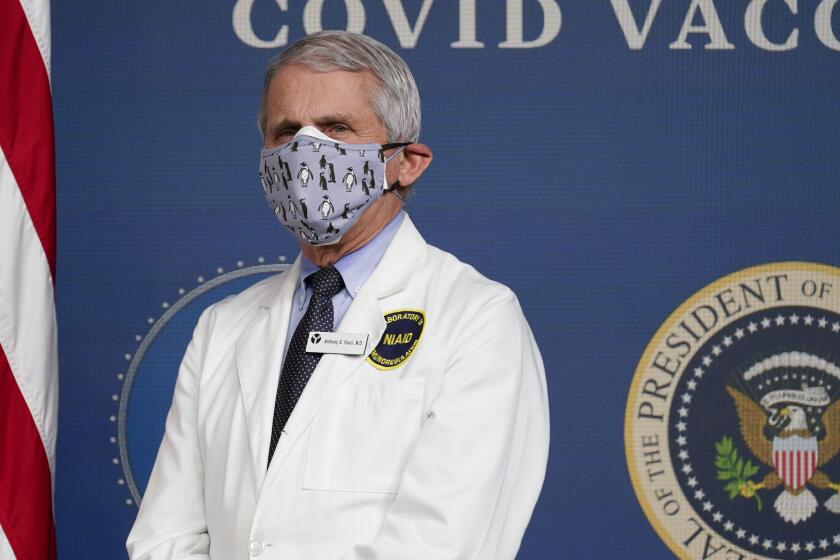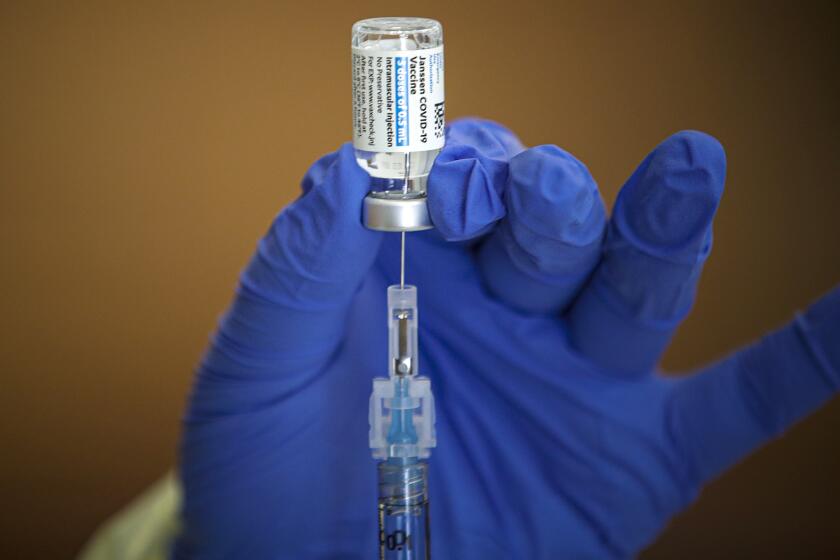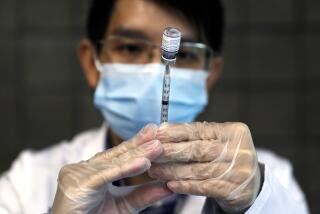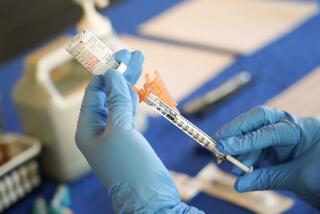Most U.S. residents who remain unvaccinated will need convincing, poll finds

- Share via
Fewer Americans are reluctant to get a COVID-19 vaccine than just a few months ago, but questions about side effects and how the shots were tested still hold some back, according to a new poll that highlights the challenges at a pivotal moment in the U.S. vaccination campaign.
Just 11% of people who remain unvaccinated say they definitely will get the shot, while 34% say they definitely won’t, according to the poll by the Associated Press-NORC Center for Public Affairs Research.
That leaves a large swath of Americans in the middle who may still roll up their sleeves — including 27% who say they probably will and 27% who say they probably won’t — if someone credible addresses their concerns.
That’s where National Institutes of Health immunologist Kizzmekia Corbett comes in.
Corbett helped lead development of the Moderna shot, and she spends hours giving plain-spoken answers to questions from Americans — especially Black Americans like her — to counter misinformation about the three vaccines used in the U.S.
No, COVID-19 vaccines won’t cause infertility: “Whoever started that rumor, shame on you.”
No, the shots’ speedy development doesn’t mean corners were cut: “We worked our butts off for the last six years” hunting vaccines for earlier cousins of COVID-19 — a head start that made the difference, Corbett said.
Getting as many people vaccinated as fast as possible is critical to returning the country to normal. More than 150 million people — about 58% of all adults — have received at least one dose, according to the Centers for Disease Control and Prevention.
What kinds of activities are safe for families to do when the adults are fully vaccinated but the kids aren’t?
As that number grows, reluctance is inching down. Overall, the AP-NORC poll found about one-fifth of American adults said they probably or definitely wouldn’t get vaccinated, compared with about one-third in January, when the shots were just rolling out.
Black Americans likewise are becoming more open to the shots, with 26% now saying they definitely or probably won’t get vaccinated, compared with 41% in January. That’s similar to the 22% of Latino and white Americans the poll found unlikely to get vaccinated. Among Asian Americans, just 9% said they definitely or probably wouldn’t get the shots.
Holdouts are from all over American society — fueling experts’ advice that there is no one-size-fits-all message on vaccines and that people need to hear from trusted sources, whether that’s scientists like Corbett or their own doctors.
Adults younger than 45, rural Americans and Republicans are especially likely to say they will avoid vaccination, the poll found. But again, attitudes are changing: 32% of Republicans now say they probably or definitely won’t get vaccinated, down from 44% in January.
“We’ve never seen an epidemic that was polarized politically before,” said Robert J. Blendon, a health policy scholar at Harvard.
About three-fourths of those who say they are unlikely to get vaccinated have little to no confidence that the vaccines have been properly tested, and 55% are very concerned about side effects, the poll found. Even among those who say they will probably get vaccinated but have not done so yet, concerns about proper testing are elevated compared to people who have received their shots already.
In forums hosted by colleges, Black pastors, doctors and even basketball great Kareem Abdul-Jabbar, Corbett says the best way to overcome distrust is to put the science in understandable terms for strangers, just like she does for family. Later this spring, she’s moving from the NIH to Harvard’s School of Public Health to continue both her vaccine research and that outreach to communities, the school was set to announce Tuesday.
The vaccines’ speedy development “is historic and it is brag-worthy,” said Corbett, whose NIH team was able to customize a shot that matched the new virus after spending six years developing vaccines against other dangerous coronaviruses such as MERS.
But “really, we should have started the conversations very early about what went into it,” she said, so the public understood that no steps were skipped.
California is hiring 2,000 canvassers to phone-bank and knock on doors, and is running a flurry of ads and testimonials about COVID-19 vaccines.
A combination of huge studies and real-world data show the main side effects of the U.S. vaccines are temporary fevers or aches as the immune system revs up. The shots are undergoing unprecedented safety monitoring, which last month led to a temporary pause in Johnson & Johnson vaccinations to determine how to handle an incredibly rare risk of blood clots.
Even after that pause, overall confidence in the vaccines is up slightly compared with a few months ago, with 45% of all adults now very or extremely confident that the shots have been properly tested for safety and effectiveness, compared with 39% in an AP-NORC poll in February.
But side effect myths persist. Corbett calls the fertility concern “completely absurd” and, in forum after forum, explains why it’s biologically impossible for the vaccines to alter anyone’s DNA.
The repetition is OK: “People need to hear things multiple times,” she said.
Experts think we have warped expectations of what it means for society to be immune from COVID-19.
Plus, many Americans have some of the same questions scientists are still trying to answer, such as whether or when people might need a booster dose.
“Those are things that even I can’t even answer,” Corbett said. “But what I can say is that we’re doing everything we can to make sure we can answer it as soon as possible.”
The AP-NORC poll of 1,842 adults was conducted April 29-May 3 using a sample drawn from NORC’s probability-based AmeriSpeak Panel, which is designed to be representative of the U.S. population. The margin of sampling error for all respondents is plus or minus 3.2 percentage points.
More to Read
Sign up for Essential California
The most important California stories and recommendations in your inbox every morning.
You may occasionally receive promotional content from the Los Angeles Times.

















